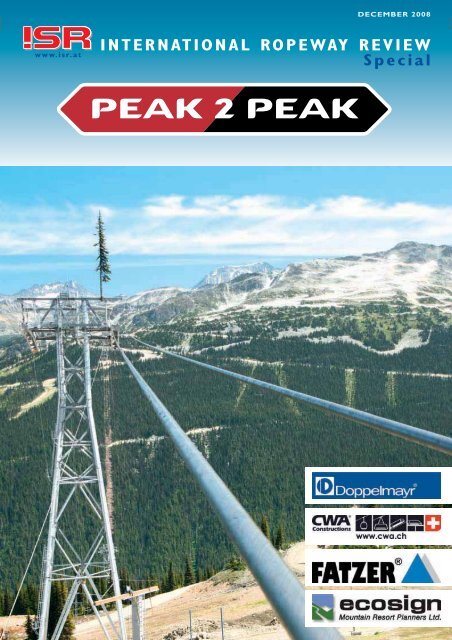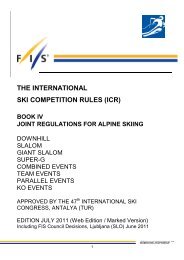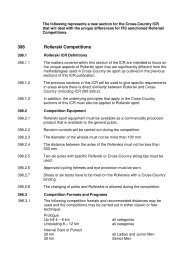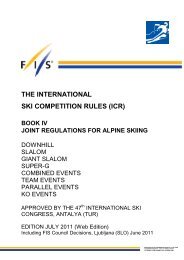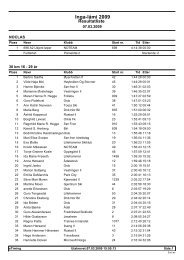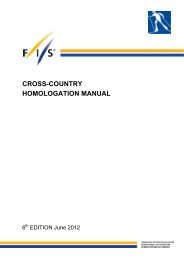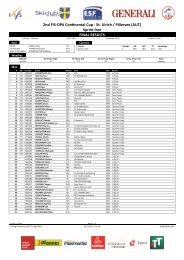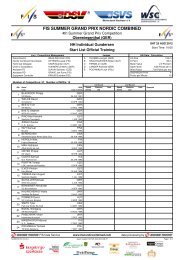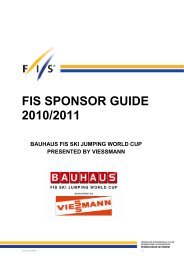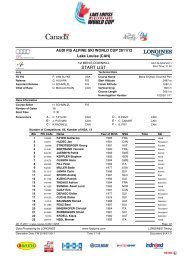You also want an ePaper? Increase the reach of your titles
YUMPU automatically turns print PDFs into web optimized ePapers that Google loves.
www.isr.at<br />
DECEMBER 2008<br />
INTERNATIONAL ROPEWAY REVIEW<br />
Special
PEAK 2 PEAK GONDOLA<br />
The Peak 2 Peak Gondola is a record-setting 3S (3 ropes) aerial tramway that was constructed<br />
by Doppelmayr during the summers of 2007 and 2008.This ropeway connects the Rendezvous<br />
Restaurant on Blackcomb Mountain with the Roundhouse Restaurant on Whistler Mountain in<br />
Whistler, British Columbia, Canada.<br />
The total length of this new ropeway is<br />
4.4 kilometers and the 28-passenger<br />
gondola cabins traverse the Fitzsimmons<br />
Valley in approximately eleven minutes.<br />
The highest point off the ground, in the<br />
center of the span, is 436 meters above Fitzsimmons<br />
Creek. The Peak 2 Peak Gondola<br />
will hold four new world records:<br />
● 4.4 km – longest lift of its type<br />
● 3024 kilometers – longest length of unsupported<br />
span<br />
● 436 meters – highest point above the<br />
ground for a cable system<br />
● 13.56 km – longest connected tourist<br />
ropeway system<br />
History – the big idea<br />
The genesis of the Peak 2 Peak Gondola<br />
occurred on February 17, 1997 when<br />
Hugh Smythe, President of Intrawest Resort<br />
Operation Group, and Paul Mathews,<br />
President of Ecosign Mountain Resort<br />
Planners Ltd., based in Whistler, British<br />
Columbia, were on a technical visit to<br />
Switzerland. After inspecting the new 150passenger<br />
aerial tramway from Blauherd to<br />
Rothhorn in Zermatt, they were in a helicopter<br />
on a flight towards the famed Matterhorn,<br />
and Mathews pointed out a silver<br />
thread in the sunlight which links the<br />
Trockener Steg station to the Klein Matterhorn.<br />
Mathews commented that the distance<br />
between the last tower on Mayer’s<br />
Plateau to the Klein Matterhorn was 2.7<br />
kilometers. Smythe asked the relevance of<br />
that fact and Mathews replied, “That is the<br />
same distance from the bottom of the Harmony<br />
Chair on Whistler Mountain to the<br />
bottom of the 7th Heaven Express on<br />
Blackcomb Mountain.” The big idea for<br />
the P2P was born that day.<br />
Mathews’ company, Ecosign, has been responsible<br />
for master planning at Whistler<br />
and Blackcomb since the mid 1970s. Upon<br />
returning home from Switzerland, Mathews<br />
and Smythe commenced drawing up the<br />
first plans for a link between the two<br />
mountains.<br />
With the technology available in 1997, it<br />
was possible to achieve a capacity of 1125<br />
persons per hour with a 125-passenger aerial<br />
tramway cabin or 1350 persons per hour<br />
with a 150-passenger cabin. The thought in<br />
those days was that this would just be a link<br />
for skiers and snowboarders during the winter.<br />
The initial concept was for a reversible<br />
aerial tramway to cross Fitzsimmons Valley<br />
with no intermediate support tower. The<br />
cost of about CAD $15 million dollars<br />
(1997) seemed astronomical at the time,<br />
but the concept was intriguing.<br />
Is the Peak 2 Peak a ski lift, a transportation<br />
solution or just a big WOW factor?<br />
Actually, Ecosign and Whistler/Blackcomb<br />
believe that the Peak 2 Peak Gondola is all<br />
three.<br />
A fantastic ski lift<br />
Hugh Smythe has always described<br />
Whistler and Blackcomb Mountains as two<br />
large mushrooms sitting side by side. There<br />
is the slender stalk up to a large cap on each<br />
mountain, with the stalk representing the<br />
access systems from the valley floor and the<br />
mushroom caps representing the large<br />
alpine bowls on each mountain. Both<br />
Whistler and Blackcomb have three major<br />
climatic zones, delineated by elevation: the<br />
lower mountain, from 775m up to about<br />
1250 meters, the sub-alpine one from 1250<br />
to 1900 meters, and the alpine zone rising<br />
up to 2250 meters. Blackcomb has two access<br />
systems, the Excalibur Gondola from<br />
Whistler Village (with an angle station at<br />
Base II) and the Wizard Chair from the<br />
Blackcomb Benchlands. Blackcomb has<br />
four high-alpine zones including 7th Heaven,<br />
Jersey Cream Bowl, the Horstman Glacier<br />
and the Blackcomb Glacier. The capacity<br />
of the sub-alpine and alpine zones on<br />
Blackcomb Mountain is 13,500 skiers per<br />
day. Whistler Mountain currently has three<br />
access systems including one from Whistler<br />
Creekside, at 650 meters elevation, up to<br />
the Roundhouse, at 1,835 meters, and two<br />
from Whistler Village: the Whistler Village<br />
Express Gondola and the Fitzsimmons and<br />
Garbanzo detachable quad chairlifts.<br />
Whistler has five alpine bowls: West Bowl,<br />
Whistler Bowl, Glacier Bowl, Harmony<br />
Bowl and Symphony Bowl. Whistler has a<br />
capacity of about 18,000 skiers per day in<br />
the sub-alpine and alpine zones. Hence, the<br />
reference to two large mushrooms.<br />
The mountains are so large and total journey<br />
time from Whistler Peak or Blackcomb<br />
Peak down to Whistler Village and back up<br />
the companion mountain is so long that<br />
skiers generally choose one mountain over<br />
the other on any given day. It is also very<br />
inconvenient to change from one mountain<br />
to the other in response to the conditions<br />
such as fog, blowing snow, wind or simply<br />
crowding. The Peak 2 Peak Gondola will<br />
change all of that forever! Customers will be<br />
able to change mountains at high elevation,<br />
from one mountain restaurant to the other,<br />
in just eleven minutes.<br />
A transportation solution<br />
Concurrent with the first idea for the Peak<br />
2 Peak Gondola, Ecosign was hired by the<br />
Resort Municipality of Whistler to draw up<br />
a comprehensive transportation strategy for<br />
the resort. The thinking then was that it<br />
would be necessary to build a road from<br />
Function Junction, at the entrance of the<br />
Resort Municipality of Whistler, that bypassed<br />
Whistler Creekside to move large<br />
flows of traffic directly to Whistler Village.<br />
This by-pass road, including intersections<br />
and bridges, had an estimated cost of about<br />
CAD $85 million (1997 dollars). It was also<br />
considered that Highway 99, within the<br />
Resort, would almost surely have to be<br />
widened to four lanes to accommodate the<br />
ever increasing volume of traffic. Armed<br />
with the new idea for the Peak 2 Peak,<br />
Mathews and consulting transportation engineer<br />
Reid Crowther built a model of the
transportation and traffic systems to show<br />
that, with the Peak 2 Peak, it was unlikely<br />
that these large and expensive highway upgrades<br />
would be necessary. If the Peak 2<br />
Peak tramway were built, day skiers and<br />
overnight guests could simply go to the lift<br />
closest to their parking lot or accommodation<br />
and quickly access the mountain of<br />
their choice, or even ski both mountains.<br />
Whistler and Blackcomb have five entry<br />
portals: Whistler Creekside, Whistler Village<br />
to Whistler Mountain, Whistler Village<br />
to Blackcomb Mountain, the Wizard base<br />
to Blackcomb Mountain and Base II on<br />
Blackcomb. Without the Peak 2 Peak, people<br />
parking or sleeping in any one of these<br />
five neighbourhoods or entry portals normally<br />
must move by car or bus to the portal<br />
of their choice. The transportation model<br />
proved that a ropeway across the valley connecting<br />
the two mountains could save the<br />
Resort Municipality of Whistler the huge<br />
expense and the environmental impacts of a<br />
four-lane highway bisecting Whistler Valley.<br />
While certain people wonder at the cost of<br />
the Peak 2 Peak Gondola, Whistler/Blackcomb<br />
may well have saved local taxpayers<br />
something in the order of CAD $100 million.<br />
A big WOW factor<br />
We are confident that the Peak 2 Peak Gondola<br />
will substantially increase the attractiveness<br />
of Whistler and Blackcomb. When<br />
visitors travel up the Wizard and Solar<br />
Coaster high-speed chairlifts to the Rendezvous<br />
Restaurant on Blackcomb Mountain,<br />
cross the Fitzsimmons Valley to reach<br />
the Roundhouse Restaurant on Whistler<br />
Mountain and then ride back down 5 kilometers<br />
on the Whistler Express to Whistler<br />
Village, these summer and winter tourists<br />
will have traveled 13.6 kilometers on a connected<br />
aerial ropeway system. This will provide<br />
unsurpassed views of the resort in the<br />
valley and the pristine wilderness of the<br />
glaciers in Garibaldi Park and will provide<br />
unique mountain experiences for people of<br />
all ages from around the world.<br />
Ecosign’s responsibility for the<br />
Peak 2 Peak<br />
������� �������<br />
l Development of the general concept<br />
l Refinement of the concept with the<br />
Whistler/Blackcomb management team<br />
l Evaluation of different systems<br />
l Detailed terminal site planning<br />
Paul Mathews<br />
�������� �������� ������ ������ �������� �������� ���� ����<br />
ISR: What were<br />
the main challenges<br />
in handling<br />
the project?<br />
P. Mathews: The<br />
main challenge<br />
was to convince<br />
anyone that this<br />
amazing lift<br />
made sense. Lat-<br />
INTERVIEW<br />
Paul E. Mathews, President,<br />
Ecosign Mountain<br />
Resort Planners Ltd.<br />
er the challenge was financing CAD 52<br />
million then finally, logistics as how to<br />
get all of that steel, concrete and ropes<br />
up the mountains.<br />
How long did the planning phase last?<br />
From Feb. 1997 until 2007 when construction<br />
began.<br />
Is Peak2Peak the limit for ropeway engineering,<br />
or are there even bigger<br />
things to come?<br />
So far as I understand it, this is quite at<br />
the limit of current technology. It will<br />
hold 4 world records; total length, free<br />
span, height above the ground and total<br />
connected tourist ropeway of 13.6 km.<br />
Will there be larger, higher, longer lifts in<br />
the future? Sure.<br />
Photo: Ecosign
Photos:Whistler Blackcomb<br />
Operating Company –<br />
Dave Brownlie, President and<br />
CEO, Whistler Blackcomb<br />
ISR: What prompted<br />
your company to<br />
launch this exciting<br />
project?<br />
D. Brownlie: We<br />
asked ourselves<br />
many questions and<br />
challenged our current business model by<br />
asking the following: Who is our customer<br />
today and who will our customer be in the<br />
future? How will we grow our business beyond<br />
the 2010 Games? How do we leverage<br />
our unique assets? How will we differentiate<br />
ourselves in the market place? How can we<br />
drive our business all year round? As we answered<br />
those questions, we started to get very<br />
excited about the opportunity of joining our<br />
two mountains with the Peak 2Peak Gondola.<br />
What makes Peak 2 Peak so special for you<br />
as the operator?<br />
The Peak 2 Peak will dramatically enhance<br />
the guest experience on our mountains both<br />
in winter and summer. With Peak 2 Peak<br />
more will be accessible to all of our guests<br />
every day, including variety, snow, glaciers,<br />
bowls and restaurants. The Peak 2 Peak will<br />
be one more reason that Whistler Blackcomb<br />
is the No. 1 resort in the world. On a professional<br />
basis, the planning, development, construction<br />
and operation of a lift of this size<br />
and scale is a wonderful opportunity.<br />
And what makes it special for the user?<br />
In the winter time it is about the experience<br />
on the mountain, and Peak 2 Peak joins all<br />
of what Whistler Blackcomb have to offer<br />
every day in an 11-minute ride. In the summer,<br />
the Peak 2 Peak will be a must see must<br />
do attraction with its unsurpassed views of<br />
both rugged alpine rock and ice on one side<br />
and a resort village nestled between the two<br />
mountains on the other. At 4.4 kilometres in<br />
length and a 3 km free span the Gondola<br />
breaks three world records; an engineering<br />
feat in itself.<br />
Whistler Blackcomb Interviews<br />
Stuart Rempel, Senior VP of<br />
Marketing and Sales, Whistler<br />
Blackcomb<br />
ISR: Peak2Peak is<br />
already being touted<br />
as the new hallmark<br />
of Whistler<br />
Blackcomb. What<br />
impacts do you<br />
think the new installation<br />
will have<br />
on tourism in the<br />
region as a whole?<br />
S. Rempel: Whistler Blackcomb’s new Peak<br />
2 Peak Gondola will become a year-round<br />
attraction for Whistler and will become<br />
Canada’s and British Columbia’s newest<br />
tourism icon. It will clearly differentiate<br />
Whistler from any other resort in North<br />
America. Whistler is already one of the<br />
most popular mountain resort destinations.<br />
Awareness of Whistler and the Peak 2 Peak<br />
Gondola will benefit greatly from international<br />
exposure from the 2010 Olympic<br />
and Paralympic Winter Games.<br />
Photo:Whistler Blackcomb<br />
Arthur DeJong, Mountain Planning<br />
and Environmental Resource<br />
Manager, Whistler Blackcomb<br />
ISR: The ecological<br />
footprint of a project<br />
is now a decisive<br />
factor in the<br />
field of leisure<br />
amenities. What<br />
environmental impact<br />
did the Peak<br />
to Peak Gondola have on your resort?<br />
A. Dejong: Clearly the most significant<br />
portion of the Peak 2 Peak footprint is the<br />
terminals. Both terminals were placed in a<br />
preexisting development area, dramatically<br />
reducing the net impact. Lift line width<br />
ranged from 10 to 20 meters, facilitating<br />
the lay-out and placement of cable. The<br />
overall footprint of Peak 2 Peak is very<br />
comparable to a typical detachable quad<br />
placement on Whistler Blackcomb.
Doug Forseth, Senior VP of Operations<br />
for Whistler Blackcomb<br />
ISR: Can you tell us<br />
something about the<br />
planning process<br />
and the financial<br />
side? How long did<br />
the planning phase<br />
last? Were there any<br />
special problems?<br />
And what level of<br />
capital spending are we talking about?<br />
D. Forseth: The general idea was born in<br />
the late 1990s when Hugh Smythe (Senior<br />
VP of Mountain Resorts, Intrawest) was in<br />
Europe looking at ski areas with Paul Mathews,<br />
president of Ecosign Mountain Planners.<br />
Intrawest had recently purchased<br />
Whistler Mountain and Hugh was dreaming<br />
about connecting Whistler and Blackcomb<br />
Mountains at the alpine elevations.<br />
More formal planning got underway in<br />
2005 when discussions started with Doppelmayr<br />
and Ecosign about what type of<br />
lift(s) might be used to connect the two<br />
mountains from the restaurant elevations of<br />
Whistler and Blackcomb. Envisioning sessions<br />
were conducted with numerous Intrawest/Whistler<br />
Blackcomb entities to<br />
brainstorm what we thought the project<br />
might look like and to vet all possible options.<br />
Several Whistler Blackcomb and<br />
Doppelmayr people did a field trip to<br />
Kitzbuhel, Austria to see first hand a similar<br />
3S gondola in operation. Terminal locations<br />
and various combinations of lift equipment<br />
were considered but ultimately the jig-back<br />
tram (like Grouse Mountain) was the chosen<br />
solution and today’s location of the terminals<br />
on each mountain was determined.<br />
Numerous activities were undertaken in the<br />
summer of 2005:<br />
a) Geotechnical studies were completed.<br />
b) Initial business plans were drafted to<br />
make the business case for this investment.<br />
One of the outcomes was that the jig-back<br />
tram concept would very quickly prove to<br />
have inadequate capacity and therefore was<br />
not a good response to this opportunity.<br />
Doppelmayr then proposed their 3S Gondola<br />
technology, which more than doubled<br />
the capacity. The decision to go for a different<br />
type of ropeway was a $20 million<br />
change. So it was back to the business case<br />
for consideration of what the additional<br />
cost and increased capacity meant for the<br />
viability of the project. But it still penciled<br />
out and we continued to plan and seek Intrawest’s<br />
final approval for the project.<br />
c) Doppelmayr was funded to carry out<br />
the preliminary technical design of the<br />
newly selected 3S Gondola. Their work included<br />
foundation designs, ground profile<br />
surveys, code issues, cabin configuration,<br />
airplane warning systems, transportation of<br />
the ropes and lift components from Europe<br />
to Whistler, evacuation systems and production/installation<br />
schedules.<br />
Applications for the project were lodged<br />
with the British Columbia Provincial government<br />
early in the fall of 2005, with approvals<br />
received about four months later.<br />
In 2006 a selection was made to choose<br />
Cannon Designs as the architects of the terminal<br />
structures. and the initial concepts<br />
were developed.<br />
Community consultation was performed in<br />
late 2005 and early 2006 to explain the<br />
project to the citizens of Whistler, BC. Presentations<br />
were also made to the local municipal<br />
government in order to get their approval<br />
and support.<br />
During 2006, Intrawest Corporation had<br />
launched a review of where the company<br />
was best positioned to move ahead. All options<br />
were being considered, and by late<br />
summer it was becoming obvious that in<br />
fact Intrawest Corporation was likely to be<br />
sold. Commitment to a $51 million project<br />
would obviously have a material effect on<br />
the sale, and it was decided to suspend the<br />
project until the future direction of Intrawest<br />
Corporation was settled. Discussions<br />
were undertaken with the prospective<br />
buyer Fortress to advise them of the Peak 2<br />
Peak project and the possibilities/commitments<br />
that would come with the project.<br />
Business plans were shared with Fortress in<br />
an attempt to bring them into the picture<br />
and provide them with essential information.<br />
With a possible construction start in<br />
May 2007, it was essential that no time be<br />
lost. Design work still needed to be completed<br />
on the lift equipment as well as the<br />
terminal structures. The sale of Intrawest<br />
was completed in late October 2006 and<br />
Fortress as the new owners immediately put<br />
their minds to seriously reviewing the Peak<br />
2 Peak business plan. After about 90 days of<br />
review, Fortress gave their approval to continue<br />
the project. Construction commenced<br />
in May 2007 and Phase One was wrapped<br />
up in early November of that year. The primary<br />
goal of Phase One was to have all of<br />
the concrete poured for both terminals and<br />
all four towers as well as erecting towers 2<br />
and 3. Tough early winter conditions hampered<br />
the construction schedule in September<br />
and October 2007. Roads had to be<br />
plowed, and moving concrete to the alpine<br />
was a difficult task. However, all but three<br />
concrete pours were completed and that left<br />
us in a good position to resume construction<br />
in April 2008. Construction was completed<br />
by fall 2008.<br />
5
Photo: R. O’Neill<br />
INTERVIEWS<br />
Peter Luger, project manager<br />
ISR: What were the main challenges in the implementation<br />
of the project?<br />
P. Luger: With such a mega project, there are very<br />
many constantly changing challenges. I would like<br />
to limit my remarks here to what I found to be the<br />
three biggest.<br />
Developing the project, planning the ropeway engineering and observing<br />
the work schedules: With its 3km span, a new and highly aesthetic tower<br />
design in the form of tubular lattice work, and the need for close collaboration<br />
with the management at Whistler / Blackcomb and the local planners,<br />
the project was basically one long challenge. And the nine hours time difference<br />
also helped to ensure that my working day was often very long.<br />
Collaboration with the Canadian ropeway authority (BCSA) and the individual<br />
rulings required to get the 3S system approved constituted a further<br />
challenge that needed my attention throughout. The Canadian ropeway<br />
code does not cover such an innovative and complex system as a 3S gondola.<br />
That made it necessary to submit requests for variances for all the items<br />
where the Peak 2 Peak diverges from Canada’s CAN/CSA Z98-01.<br />
On-site installation and co-ordination of the work has also been one of the<br />
main challenges in the last two years. With the help of the fantastic, highly<br />
motivated teams from Austria, Canada and Switzerland, we really rose to<br />
this challenge! The installation team leaders in particular did a superb job;<br />
I merely had to provide the support.<br />
Could you briefly describe the main phases of the work on site?<br />
Erection of towers 3 and 2 in the period from 27 August to 21 October<br />
2007. That meant we achieved our goal for the first year on site before the<br />
snows came.<br />
Installation of the terminal systems in May and June 2008. At the same<br />
time towers 1 and 4 were erected, and the finishing touches put to towers 2<br />
and 3, which are 62.5 m high. In the first five weeks, the terminal installation<br />
team from Wolfurt and Canada showed such commitment that they<br />
were able to make up for the two-week delay to the commencement of<br />
works caused by the amount of snow on the ground.<br />
Transporting the ropes from the Fatzer plant in Romanshorn to the top of<br />
Blackcomb Mountain.<br />
Rope stringing from May to September 2008. The complex preparations<br />
for stringing were performed simultaneously with installation of the terminal<br />
and line equipment. And stringing could begin the moment the first<br />
track rope arrived at the terminal. That was a real challenge for our Swiss<br />
colleagues from Garaventa, and it was handled with perfect planning and<br />
organization.<br />
Installation of the electrical systems for the Peak 2 Peak Gondola and the<br />
four evacuation gondolas from mid-June to the end of September 2008.<br />
Installation and commissioning of the evacuation systems at the end of August<br />
and beginning of September 2008.<br />
Assembly and finishing work on the 28 carriers in September.<br />
Final adjustments and internal start-up of the complete installation in<br />
October.<br />
Final inspection and approval by the authorities in November, with the<br />
whole system ready to go right on time on 15 November 2008.
Warren Sparks,<br />
Executive Vice-President<br />
& General Manager<br />
Doppelmayr CTEC Ltd<br />
ISR: What do you think were the decisive<br />
criteria in choosing a Doppelmayr ropeway?<br />
W. Sparks: The Doppelmayr and Whistler<br />
Blackcomb relationship goes back to the mid<br />
1980s. Doppelmayr has supplied the majority<br />
of their 38 lifts. Doppelmayr developed<br />
the tricable gondola technology, which is the<br />
only product suitable for a profitable business<br />
model for the Peak to Peak ropeway<br />
link. Whistler is determined to be the best<br />
Michael Doppelmayr, CEO<br />
Doppelmayr/Garaventa Group<br />
ISR: The 3S Peak 2 Peak is now complete<br />
and it is one of the world’s most spectacular<br />
ropeways. How do you feel about it?<br />
M. Doppelmayr: Real good! The success of<br />
such a huge project can never be taken for<br />
granted. But in this case, everyone involved in<br />
the project did a fantastic job. My thanks go<br />
to Whistler and Blackcomb for placing their<br />
trust in us and giving us the opportunity to<br />
show just what we can do. I am grateful to all<br />
our subcontractors and partners who have<br />
contributed to the success of the project. And<br />
last but not least, I want to say a big thankyou<br />
to our employees, to our teams in Canada,<br />
Switzerland and Austria for their total<br />
commitment. It was the perfect interaction of<br />
all parties to the project that made it possible<br />
to rise to the challenge in such convincing<br />
style. I wish Whistler and Blackcomb every<br />
success with their operations, with a zero accident<br />
rate, and I wish the users a great time as<br />
they enjoy the feeling of flying!<br />
What is the position of the 3S system within<br />
the Doppelmayr product portfolio?<br />
The 3S is a very important system for us – for<br />
one thing because we are still the only ropeway<br />
manufacturer worldwide to have actually<br />
built such a ropeway. We have been able to<br />
further develop the 3S system thanks to the<br />
know-how of our group affiliate VonRoll. And<br />
of course, our pioneering role with this system<br />
also strengthens our position as the technolog-<br />
ski area in the world and so they chose the<br />
best ropeway manufacturer in the world.<br />
How long did the negotiations last?<br />
We have been looking at a solution for the<br />
Peak to Peak link for over ten years. We<br />
considered gondola systems down to the<br />
valley and we also considered large reversible<br />
tramways. But only the tricable<br />
gondola pencils out for this application.<br />
Can you say something about the contract<br />
award process for such a project?<br />
The contract award process normally re-<br />
ical and innovation leader in the international<br />
ropeway industry.<br />
Do you expect more orders for 3S to come in<br />
now that Peak 2 Peak has been completed?<br />
With its record-breaking unsupported span<br />
and other benchmark features, the 3S Peak 2<br />
Peak is obviously a very special ropeway. But<br />
for me, that is not really the question. What is<br />
much more important is that we can offer the<br />
right system for every ropeway application and<br />
project, whether it be a 3S, 2S, Funitel or a<br />
continuously circulating gondola.<br />
Do you know of any other operators interested<br />
in a similar solution, i.e. crossing a deep<br />
valley to connect two ski areas?<br />
No, there are no interconnection projects like<br />
Whistler/Blackcomb in the pipeline at the<br />
moment. But there are several projects worldwide<br />
in which our 3S technology is called for.<br />
But of course, I can’t disclose any details at<br />
this moment in time.<br />
quires several years<br />
to properly present<br />
and explain enough<br />
details and specifications<br />
so each party<br />
understands exactly<br />
the scope and<br />
timing of their respective<br />
contributions. If the contract documents<br />
are drawn up and written properly,<br />
there is usually much less confusion and debate<br />
during and after execution of the project.<br />
Nonetheless, any successful project also<br />
requires a great deal of trust, fairness, goodwill,<br />
cooperation, communication and<br />
commitment on both sides.<br />
Photo: Doppelmayr Photo: J. Schramm<br />
7
Photo:Archive ISR<br />
Why a 3S system?<br />
Professor Josef Nejez, ISR,<br />
explains the technical reasons<br />
for the choice of the 3S system<br />
for the Peak to Peak Gondola.<br />
In order to understand<br />
why<br />
the 3S system was<br />
found to be the<br />
optimum solution<br />
for linking two ski<br />
areas located on<br />
either side of a<br />
deep valley, we<br />
must first of all<br />
consider the basic<br />
Prof. Dr. Josef Nejez<br />
differences in<br />
terms of engineering and operation between<br />
the main types of aerial passenger ropeways<br />
on the market today.<br />
The main differences between modern<br />
ropeway systems concern the number of<br />
ropes employed and the mode of operation.<br />
With regard to the ropes, the basic distinction<br />
is between monocable and bicable configurations,<br />
and for the mode of operation<br />
between reversible (jigback) and continuously<br />
circulating systems.<br />
The ropes<br />
In the case of a monocable system, fixed or<br />
detachable grips are used to attach the carriers<br />
to a rope that provides support and traction<br />
at the same time. The rope employed<br />
on a monocable system is called the haul<br />
(or hauling) rope.<br />
On a bicable system, the carriers are suspended<br />
from a carriage that travels along a<br />
track rope and is pulled by a separate haul<br />
rope. In this case, carrier support and traction<br />
are distinct functions performed by<br />
two ropes of different construction. The<br />
track ropes take the form of full-locked coil<br />
ropes, which are highly compact on section<br />
and thus ideally suited to absorb shear loads<br />
(wheel loads from the carriages). The haul<br />
ropes are round strand Lang’s lay ropes,<br />
which have two key characteristics that fulllocked<br />
coil ropes do not: the flexibility<br />
needed to negotiate the rope sheaves and<br />
suitability for splicing so as to create an<br />
endless loop. The hauling rope on a monocable<br />
system must also meet that require-<br />
Photos:Whistler Blackcomb<br />
Although the haul rope is not yet in place<br />
here, the rope configuration for the<br />
3S system is clear.<br />
ment and the same rope construction is accordingly<br />
used as for the haul rope on a bicable<br />
system.<br />
There are other significant differences between<br />
full-locked coil ropes and round<br />
strand ropes which affect their potential uses<br />
in the field of ropeway engineering,<br />
namely the rope strength design factor, fill<br />
factor (share of the metallic section in the<br />
geometrical section of the rope) and rope<br />
surface. Compared with round strand<br />
ropes, the full-locked coil ropes used as<br />
track ropes can have a lower rope strength<br />
design factor, while the fill factor is higher<br />
and the rope surface is much smoother. The<br />
lower design factor and higher fill factor<br />
provide for longer spans, while the<br />
smoother surface provides a better track for<br />
the carriage wheels.<br />
So far we have only referred to one track<br />
rope and to one haul rope or hauling rope,<br />
meaning a rope that serves to provide support,<br />
traction or both support and traction.<br />
But each of these functions can be assigned<br />
to more than one rope. On big jigbacks,<br />
this is usually the case with regard to the<br />
support function; instead of just one track<br />
rope such installations are built with two<br />
parallel track ropes. Similarly, if the haul<br />
rope on a continuous loop system (gondola)<br />
is replaced by two parallel synchronized<br />
haul ropes with a gage that is wider than<br />
the width of the carrier, we have what is<br />
No need to be a tightrope walker for a highlevel<br />
walk on the 3S system!
known as a Funitel system. Installations<br />
with two or more haul ropes are not normally<br />
built today, however.<br />
Operating mode<br />
In the case of a reversible system or jigback,<br />
the cars travel to and fro between the terminals.<br />
They do not pass through the stations.<br />
In the normal case, a reversible operates<br />
with two carriers, which have a bigger capacity<br />
than the gondolas on a continuous<br />
loop system. System capacity on a reversible<br />
is determined by carrier capacity and transit<br />
time (including dwell time in the terminals).<br />
This means that system capacity also<br />
depends on line speed and the length of the<br />
line.<br />
A circulating system, on the other hand,<br />
operates with a large number of smaller carriers<br />
moving continuously in the same direction<br />
on two lines (uphill and downhill)<br />
between the terminals, and the carriers pass<br />
through the stations. In this case system capacity<br />
depends on individual carrier capacity<br />
and the time interval between the carriers<br />
but not on line length.<br />
From these distinctions and other ropeway<br />
engineering fundamentals (output of the<br />
primary mover, rope tension, etc.), the following<br />
basic principles can be defined for<br />
the choice of operating mode:<br />
Reversibles are the system of choice for<br />
short, steep lines with a significant vertical<br />
difference between the terminals and also<br />
for long unsupported spans.<br />
Circulating systems are ideal for long lines<br />
with relatively little vertical, with monocables<br />
used for short spans and bicable solutions<br />
for medium spans.<br />
The 3S system<br />
In certain respects the 3S combines the respective<br />
advantages of reversible and circulating<br />
systems. In terms of ropeway engineering,<br />
the 3S is a bicable circulating system<br />
with twin track ropes. In the case of<br />
the Peak 2 Peak, this rope configuration is<br />
the key to the record-breaking 3 km unsupported<br />
length of the middle span and to a<br />
design capacity of 2050 P/h and direction.<br />
A comparison between the 3S and reversible<br />
systems shows that, for the 4.4 km<br />
line linking Whistler and Blackcomb, a reversible<br />
would have to operate with 300passenger<br />
cabins for the same system capacity.<br />
That is 50% more than the biggest reversible<br />
cabins built to date. The stop-and-<br />
go mode of operation with the relatively<br />
long terminal dwell times required for passenger<br />
handling with such big cabins would<br />
be much less efficient than the comparatively<br />
continuous traffic flows available with<br />
the 28-passenger gondolas actually chosen.<br />
A conventional bicable installation would<br />
not have been the solution for the Peak 2<br />
Peak either because of the very long unsupported<br />
span across the valley. In the case of<br />
a bicable circulating system, the haul rope<br />
can be supported by sheave trains on the<br />
towers but haul rope support between the<br />
towers is only provided by the carrier grips.<br />
This means that the weight of the haul rope<br />
is transmitted to the track rope via the gondola<br />
carriages. This mechanism is especially<br />
problematical when the gondolas are fed<br />
onto the line at the start of operations in<br />
the morning and again when they are taken<br />
off the line in the evening; when the first<br />
gondola enters a rope span in the morning<br />
and the last gondola exits the span in the<br />
evening, half the weight of the haul rope in<br />
that span is supported by the grip on the<br />
gondola and is transmitted to the track rope<br />
via the carriage. That involves very considerable<br />
additional loads on various components<br />
with a number of negative consequences,<br />
e.g. on the service life of the track<br />
rope.<br />
With the 3S system, the problem is solved<br />
with the help of slack carriers with an integrated<br />
haul rope support sheave attached to<br />
the track ropes at relatively short intervals.<br />
That ensures even distribution of the<br />
weight of the haul rope on the track ropes.<br />
It also avoids longitudinal swing in the carriers<br />
resulting from the dynamics of acceleration<br />
and deceleration (starts and stops)<br />
and avoids the danger of haul rope entanglement.<br />
This solution has long been em-<br />
performance in strong winds.<br />
ployed on big reversibles with double track<br />
ropes.<br />
Another big advantage of the 3S system is<br />
also worth mentioning, and that is its outstanding<br />
wind stability. The twin track<br />
ropes act as dampers on lateral swing in the<br />
carriers, and that is the key to the exceptional<br />
performance of the 3S in side winds.<br />
The Peak 2 Peak Gondola, for example, is<br />
designed to operate in 80 km/h winds,<br />
which makes it the least susceptible to<br />
strong winds of all the Whistler Blackcomb<br />
lifts.<br />
In summary, one is tempted to say that, had<br />
the 3S system not yet existed, it would have<br />
been necessary to invent it for the link between<br />
Whistler und Blackcomb!<br />
Josef Nejez<br />
3S Peak 2 Peak Gondola<br />
Altitude Whistler terminal 1834 m<br />
Altitude Blackcomb terminal 1870 m<br />
Vertical height 36 m<br />
Line length 4400 m<br />
No. of towers 4<br />
Tower height 35 – 65 m<br />
Longest span 3024 m<br />
Max. height above ground 436 m<br />
Track ropes 2 x 56 mm<br />
Haul rope 46 mm<br />
Drive terminal Whistler<br />
Drive output (continuous) 520 kW<br />
Tensioning terminal Blackcomb<br />
Haul rope loop 8850 m<br />
No. of carriers 28<br />
Carrier capacity 28 pers.<br />
Line speed 7.5 m/s<br />
Carrier interval 49 s<br />
Transit time 11 min<br />
System capacity 2050 P/h<br />
TECHNICAL DATA The 3S configuration offers excellent<br />
9
Swiss ropes shipped<br />
across the Atlantic<br />
The Swiss ropes for the spectacular Peak 2 Peak 3S gondola arrived<br />
at their destination in Whistler, Canada, right on schedule<br />
on 17 June after a journey of 18,000 kilometers.<br />
Five rope reels weighing a total of over<br />
440 t were shipped to the Canadian ski<br />
resort from the wire rope production plant<br />
of Fatzer AG in Romanshorn (Switzerland)<br />
in what was a feat of logistics: by truck<br />
from the plant to Basle’s Rhine port, by<br />
barge up the Rhine to Vlissingen (Netherlands),<br />
by ship across the Atlantic and<br />
through the Panama Canal to the Port of<br />
Vancouver in Washington State (USA), and<br />
then by train to Whistler. There the ropes<br />
were hauled up to an elevation of 1860 m<br />
on Blackcomb Mountain on a special heavy<br />
haulage trailer ready for the 12-14 week<br />
stringing process. That involved air-lifting a<br />
straw line across the valley and then drawing<br />
in successively thicker ropes until the<br />
Photos: Omnitrans Corp. Ltd.<br />
actual track ropes and the haul rope could<br />
be pulled into place.<br />
The stringing and tensioning operations<br />
were completed during the summer, with<br />
the haul rope splice performed on August<br />
29 and 30.<br />
The splice in itself is a noteworthy acheivement;<br />
it is 68 m / 220 feet long, and it took<br />
a fourteen-man crew over fifteen hours to<br />
complete. Norm Duke, a Fatzer AG certified<br />
splicer from Wyoming, led the team of<br />
seven Whistler Blackcomb employees and<br />
six Doppelmayr/Garaventa employees to do<br />
the job.<br />
It is what is called a long splice, with the<br />
strands from each end of the cable untwined<br />
and then re-braided together with-<br />
TECHNICAL DATA<br />
INTEGRA track ropes<br />
4 ropes, each<br />
- 4760 m long<br />
- 56 mm in diameter<br />
- weighing 85 t<br />
- or 90 t including the reel<br />
STABILO haul rope<br />
1 rope<br />
- 9490 m long<br />
- 46 mm in diameter<br />
- weighing 76 t<br />
- or 82 t including the reel<br />
out the plastic core of the rope to ensure a<br />
perfect bind that maintains the haul rope’s<br />
diameter of 46 mm. Norm Duke has<br />
spliced many of Whistler Blackcomb’s<br />
Fatzer ropes and most recently worked on<br />
the Symphony Express.<br />
Doppelmayr’s unique 3S gondola technology<br />
has each cabin traveling along two 56<br />
mm track ropes which bear the weight of<br />
the Sky Cabins, with the haul rope pulling<br />
in the middle of the two tracks. Each track<br />
rope exerts the force of a Boeing 747-400 in<br />
mid-flight on each terminal building! The<br />
haul rope was the only splice needed for the<br />
PEAK 2 PEAK Gondola since the track<br />
ropes are stationary and do not loop from<br />
Blackcomb to Whistler.
Max Baumann,<br />
Vice President<br />
Marketing &<br />
Sales,<br />
Fatzer AG<br />
ISR: Do ropes for<br />
3S installations<br />
have to meet any<br />
special requirements?<br />
M. Baumann: Wire ropes for 3S systems<br />
have to meet the same requirements as on<br />
normal jigbacks and gondolas. Apart from<br />
dimensional accuracy, breaking strength<br />
and precise length of lay, such ropes must<br />
above all have as little twist and tension as<br />
possible so that the challenging task of<br />
stringing is not made even more difficult.<br />
How was the stringing handled on the<br />
Peak 2 Peak Gondola?<br />
The crews from Garaventa and Doppelmayr<br />
did a great job. Low loaders hauled<br />
the almost 90 t ropes up to Blackcomb<br />
Mountain terminal. From there straw lines<br />
were used to pull successively thicker ropes<br />
and finally the actual track and haul ropes<br />
down the valley to Fitzsimmons Creek<br />
with the help of a temporary cable lift.<br />
INTERVIEW<br />
From there a second cable lift provided the<br />
power to pull the ropes up Whistler<br />
Mountain’s flank to the terminal station<br />
there.<br />
Can there be any increase on this gigantic<br />
system?<br />
The Peak 2 Peak Gondola has 56 mm<br />
track ropes and a 46 mm haul rope loop<br />
with a total weight of 342 tons. That is<br />
pretty impressive.<br />
But the Tung Chung bicable gondola built<br />
by Leitner had 70 mm track ropes and<br />
42 mm haul ropes plus lightning conductor<br />
cables and evacuation ropes weighing a<br />
total of 485 tons. The 42 mm haul rope<br />
for the second stage was 11.1 km long and<br />
weighed just under 86 tons, while the two<br />
4 km track ropes weighed 112.8 tons each.<br />
That must make them the heaviest track<br />
ropes ever employed on a ropeway!<br />
We are currently working on the ropes for<br />
two industrial ropeways for the Linth-<br />
Limmern hydropower scheme in Switzerland.<br />
They have a total weight of 885 tons,<br />
and the 90 mm track ropes are presumably<br />
the thickest ropeway track ropes ever installed.<br />
�����������<br />
������������������<br />
������<br />
���������������������������������������������������<br />
������������������������������������������������<br />
�����������������������������������������������<br />
������������������������������������������������<br />
�������������<br />
�������������������������������������������������<br />
�����������������������������������������<br />
�����������������������������������������������������<br />
���������������������������������������������<br />
�����������������������������<br />
�����������������<br />
������ �� ���� �����<br />
������� ���������� � �����������<br />
����� ��� �� ��� �� �� � ��� ��� �� ��� �� ��<br />
��������������� � ��������������
28 Sky Cabins from Switzerland<br />
The completion of the PEAK 2 PEAK Gondola ropeway and the arrival of 28 CWA Sky<br />
Cabins set the stage for what was the biggest construction milestone in the<br />
installation of the ropeway – the first Sky Cabin to cross the recordbreaking<br />
3 kilometre/1.88 mile unsupported span between Whistler<br />
and Blackcomb mountains.<br />
Photos:Whistler Blackcomb
ith the haul rope spliced and all<br />
“W28 Sky Cabins transported to the<br />
Blackcomb terminal, our next objective was<br />
to get the cabins on the line and send 12<br />
across the span to Whistler,” says Rick Temple,<br />
PEAK 2 PEAK Gondola construction<br />
manager. “We were able to send them over<br />
by late September, and are on track for the<br />
upcoming December grand opening.”<br />
The Sky Cabins were shipped across the Atlantic<br />
from Olten, Switzerland, where they<br />
were manufactured by CWA, global leader<br />
in the design and construction of ropeway<br />
passenger carriers. The individual crates<br />
were then loaded onto ten trucks for the<br />
journey through Canada.<br />
Cabin engineering<br />
The cabins are from the ZETA family,<br />
which has been designed specially for use<br />
on FUNITEL and 3S systems and is available<br />
in various sizes with a choice of layouts<br />
for between 20 and 40 standing or seated<br />
passengers. For PEAK 2 PEAK, a configuration<br />
with 22 seated and 6 standing passengers<br />
was selected, and the ergonomical seats<br />
are upholstered in black. There is a central<br />
seating unit with folding seats (with locking<br />
mechanism) to provide additional space according<br />
to operating requirements.<br />
The attractions of the ZETA include grade<br />
access and plenty of space with all-round<br />
panoramic views. With its wide central<br />
doors, it is ideal for wheelchair users and also<br />
for transporting goods. It is suitable for<br />
urban applications, for summer and winter<br />
tourism, and for public transport in all climate<br />
zones, with continuous hand rails<br />
available as a meaningful safety feature.<br />
ZETA cabins have an easy-to-clean non-slip<br />
checker-plate floor with forced ventilation<br />
and drainage channels.<br />
The ZETA is a 98% lightweight alloy design,<br />
with load-bearing components made<br />
of fine-grained steel. This combination of<br />
materials has proved highly successful over<br />
the years. The cabin is CE-compliant and<br />
suitable for use on all brands of ropeways.<br />
Thanks to its aerodynamic shape, the ZE-<br />
TA offers excellent performance in wind.<br />
The automatic door unit is state of the art<br />
and complies with the relevant codes and<br />
standards. It is integrated in the gondola<br />
roof and accessible from inside and outside<br />
of the cabin. The doors have remote cable<br />
operation with an actuation lever fitted to<br />
the hanger.<br />
The PEAK 2 PEAK Sky Cabins are the first<br />
ZETA cabins to have laminated safety glass<br />
windows, which have a distinct gray color.<br />
The Sky Cabins also have on-board lighting,<br />
with the lighting fittings integrated in<br />
the cabin roof, as is the p/a system. The<br />
power is supplied from a battery pack. Two<br />
of the cabins feature glass floors, enclosed<br />
by a railing, for a bird’s eye view of the<br />
Fitzsimmon’s Valley 436 metres/1,430 feet<br />
below.<br />
The contract for PEAK 2 PEAK also included<br />
delivery of a dedicated maintenance<br />
cabin with a roof hatch for working on the<br />
line.<br />
13
INTERVIEW<br />
Rico Wehrli<br />
ISR: Do the carriers for 3S installations<br />
have to meet any special requirements,<br />
and what was the reason for choosing the<br />
ZETA gondolas?<br />
R. Wehrli: CWA’s ZETA cabin was developed<br />
specially for 3S and FUNITEL systems,<br />
and so it was a logical choice for the<br />
project.<br />
What were the main challenges in your<br />
work for Peak 2 Peak?<br />
Whistler placed a strong emphasis on the<br />
design of the cabins. The glazing, for example,<br />
is laminated safety glass instead of<br />
the usual polycarbonate.<br />
The seating configuration is also new. It is<br />
in the shape of an H, with part of the central<br />
seating unit removable for summer operations<br />
so that passengers can move<br />
Felix Rhyner (left), CEO, and Rico Wehrli,<br />
Sales Manager of CWA Constructions<br />
SA/Corp.<br />
around and enjoy the view from every angle.<br />
Every gondola has on-board lighting and a<br />
public address system, and two of them<br />
have a glass floor panel so that passengers<br />
can really appreciate the heights involved.<br />
Photos:Whistler Blackcomb<br />
Photo: C.Amtmann<br />
Those two gondolas are finished in silver,<br />
in contrast to the red color used for the<br />
others.<br />
In spite of the optionals ordered, we still<br />
had to keep to the maximum weight limit.<br />
The gondolas are also fitted with a new<br />
door monitoring system, which employs<br />
magnetic induction instead of the usual<br />
mechanical system.<br />
What is so special about this project?<br />
I guess the Whistler-Blackcomb website<br />
provides the best answer to that.<br />
Can there be any increase on this gigantic<br />
system?<br />
The history of engineering shows that<br />
there is always scope for progress. I think<br />
we just have to wait and see.
TECHNICAL DATA<br />
● Cabin dimensions: 3544 x 3250 x 2400 mm<br />
● Cabin weight: approx. 1400 kg incl. glazing<br />
● Payload: approx. 2240 kg<br />
● Cabins engineered in aluminum
IMPRINT:<br />
Owner Bohmann Druck und Verlag Gesellschaft m.b.H. & Co. KG, A-1110 Wien, Leberstrasse 122, Telefon: +43(1)740 95-0, Telefax:<br />
+43(1)740 95-537, DVR 0408689, Publisher: Komm.Rat Dr. Rudolf Bohmann, Managing directors: Mag. Dr. Gabriele Ambros, Gerhard Milletich,<br />
Editorial office: Mag. (FH) Josef Schramm, Editor in chief, Mag. Christian Amtmann, Editor in charge, Mag. Alice Keönch, Assistant,<br />
e-mail: isr.zv@bohmann.at, web: www.isr.at, Advertisement sales: Dietrich Kops, Mag. (FH) Josef Schramm, Layout & electronic Publishing:<br />
Markus Frühwirth, Michael Stanek, Thomas Weber, USA – Canada: Beat von Allmen, 2871 South 2870 East, Salt Lake City, Utah 84109,<br />
Tel. +1/801/468 26 62, China: Dr. Ou LI, Dr. Schober Str. 84, A-1130 Wien, Tel. +43/1/889 74 10, Fax +43/1/889 87 19, E-Mail:<br />
unicom@aon.at, Translation: Dr. Chris Marsh, Dispatch manager: Angelika Witzmann, Tel. +43(1)740 95-462, published 6 times a year +<br />
special issues, Subscriptions rates: one-year: € 124.60 (excl. VAT, incl. mailing<br />
charges). Bank accounts: Bank Austria AG 653-092-700; Österr. Postsparkasse<br />
1732.755. Production: AV+Astoria Druck, A-1030 Wien, Faradaygasse 6, Circulation<br />
1 st half-year 2008: 7,400
Photos: Neveplast Another<br />
INTERNATIONAL ROPEWAY REVIEW 5/2008 43 SNOWTUBING<br />
good year at Neveplast<br />
Sales at Neveplast reflect a growing interest in the summer mountain infrastructure in<br />
addition to and support of the standard winter offering.<br />
Neveplast is the world leader in the production<br />
of artificial ski slopes. Following<br />
a very busy year in 2007, with a terrain<br />
park and a ski slope in Rome among the<br />
many installations built, the Italian company<br />
has again done very well this year, handling<br />
several major contracts for ski slopes.<br />
The advantage of Neveplast installations is<br />
that they offer guaranteed skiing<br />
without the use of water,<br />
and skiing on compact snow<br />
with a good side grip from<br />
sub-zero temperatures up to<br />
40 degrees C. The company’s<br />
products are engineered to the<br />
highest standards and combine<br />
a high level of safety and<br />
environmental protection<br />
with very low running costs.<br />
In addition to a number of<br />
big slopes erected for events<br />
and demonstration purposes,<br />
Neveplast also installed three<br />
permanent ski slopes in 2008<br />
using the Np30 system: a 780<br />
ft. ski slope in Kangwoland,<br />
South Korea, plus two installations<br />
in Italy, one in Mottarone<br />
above Lake Maggiore<br />
and the other in Sila, in the south of the<br />
country. Mottarone had two Tubby slopes<br />
installed in 2007, and they have been so<br />
successful that the sports and recreation<br />
area there is being upgraded to include a<br />
school camp for skiing and snowboarding.<br />
In Sila, too, Neveplast has built two Tubby<br />
slopes in addition to the 400 ft. ski slope.<br />
Neveplast has also<br />
been active on the<br />
North American<br />
market, with three<br />
Tubby slopes installed<br />
for summer<br />
snow tubing in<br />
Amesbury with a total<br />
length of 1,950<br />
feet. And there are<br />
many other Tubby<br />
installations now in<br />
place worldwide.<br />
All these orders<br />
show that ski resorts<br />
are starting to recognize<br />
the importance<br />
of developing a<br />
summer offering in<br />
addition to their<br />
core business in the<br />
winter season. Apart from being an attraction<br />
their own right, summer ski slopes,<br />
summer terrain parks and summer snow<br />
tubing slopes are an excellent vehicle for<br />
promoting winter activities in the resort<br />
during the summer period.<br />
www.neveplast.it<br />
PROMOTION
Photos:Archive<br />
ROPEWAYS<br />
A Rainforest Experience<br />
Voted Australia’s Best Major Tourist Attraction, the multi-award winning Skyrail Rainforest Cableway<br />
is recognised not only as a premier tourist experience, but as a world leader in eco-tourism.<br />
Skyrail Rainforest Cableway, Cairns Australia<br />
operates in the Barron Gorge National<br />
Park, in Australia’s World Heritage<br />
protected tropical rainforests, just ten minutes<br />
north of Cairns city. Stretching for 7.5<br />
km, it is the world's longest gondola cableway.<br />
There are 32 towers along the way,<br />
with the tallest being 40.5 m high above the<br />
rainforest floor. Gliding just metres above<br />
the rainforest canopy in comfortable sixperson<br />
gondola cabins, the Skyrail journey<br />
immerses the visitor in an intimate rainforest<br />
experience.<br />
It takes 1.5 hours to complete a one-way<br />
journey with 20 minutes spent at each station<br />
allowing scenic look-outs and giving<br />
information from the forest floor on boardwalks.<br />
Starting at Caravonica Terminal, the 6seater<br />
gondola rises high above the rainforest<br />
canopy where it pauses at Red Peak Station.<br />
This station is at the top of the mountain,<br />
and one can hop off the gondola and<br />
take a tour along the 175-m boardwalk<br />
through the rainforest.<br />
From Red Peak, the gondola continues to<br />
Barron Falls Station with its breathtaking<br />
44<br />
The Poma six-seater gondolas provide a bird’s eye view of the rainforest.<br />
views of the magnificent waterfall. From<br />
here, Skyrail descends to Kuranda Terminal<br />
– the end of the line. The little village of<br />
Kuranda is a short walk from the terminal<br />
where restaurants, shopping, and environmental<br />
shows are available.<br />
Skyrail Construction<br />
The original Skyrail concept was conceived<br />
in 1987 and was followed by seven years of<br />
pre-construction feasibility studies, an environmental<br />
impact study and numerous other<br />
reports and assessments, and consultation<br />
and approval processes with local, state and<br />
federal governments and local communities.<br />
Construction commenced in June 1994.<br />
Skyrail’s tower sites were selected to coincide<br />
with existing canopy gaps, and were<br />
surveyed to ensure no rare, threatened or<br />
endangered species would be affected by<br />
construction.<br />
Before construction commenced on the<br />
tower sites, the leaf litter and top soil were<br />
collected and stockpiled for reintroduction<br />
when construction was complete. Plant<br />
seedlings were catalogued at each site, then<br />
ENGLISH SPECIAL<br />
Skyrail Facts<br />
The cableway is 7.5 km long. It has a total of<br />
114 gondola cabins, each capable of seating<br />
six passengers, providing a carrying capacity<br />
of 700 passengers per hour in each direction.<br />
The cableway can operate at a speed of 5.0<br />
m/s; however its normal operating speed is<br />
much slower to provide guests with the maximum<br />
time to enjoy their rainforest experience.<br />
There are 32 towers in total. The highest<br />
tower is 40.5 m high.<br />
Red Peak is Skyrail’s highest station at 545 m<br />
above sea level (1,788 feet).<br />
The Kuranda Station sits at 336 m and Caravonica<br />
Terminal is only 5 m above sea level.<br />
The steepest section of the cableway has a<br />
slope of 19 degrees.<br />
Skyrail Rainforest Cableway has 15 km of<br />
40.5 mm galvanised steel rope.<br />
There is a multi-core communications cable<br />
which runs in the middle of the towers, between<br />
the two lines of haul rope. This carries<br />
all the voice and safety circuit communications.<br />
The cableway is driven by a 383 kW DC electric<br />
motor located at each drive station, the<br />
Kuranda and Caravonica Stations. Each drive<br />
station has a back-up diesel motor and a further<br />
auxiliary hydrostatic drive.<br />
Cableway Leitner POMA of America<br />
Cabins Sigma (Sigma-Composite)<br />
Haul Rope Fatzer / TrefilEurope<br />
Electric Drive ABB<br />
Diesel Drives Cummins<br />
PLC system Allen Bradley
Kamov helicopters were on duty for placing<br />
the terminal systems and towers.<br />
removed and propagated during construction,<br />
and re-planted in their original locations,<br />
with the saved top soil and leaf litter,<br />
when construction was complete.<br />
The towers were constructed in 10 m x 10 m<br />
clearings and placed as far apart as mechanically<br />
possible.<br />
The tower footings were built largely by<br />
hand, up to 5 m deep in some cases, using<br />
picks and shovels. There were no roads built<br />
during Skyrail’s construction. Workers had<br />
to walk in to the remote tower sites each<br />
day, carrying their equipment, which took<br />
up to an hour each way.<br />
Helicopters were used extensively to assist<br />
construction. The helicopters were used to<br />
carry equipment, materials and cement to<br />
INTERNATIONAL ROPEWAY REVIEW 5/2008 45 ROPEWAYS<br />
The upper part of the lattice tower being<br />
placed on the base section ...<br />
tower sites and rainforest stations. The helicopters<br />
carried their loads on 100 m long<br />
lines to avoid wind turbulence affecting the<br />
sensitive rainforest canopy.<br />
Due to the size of the tower sites, they were<br />
difficult to locate from the air, and GPS<br />
satellite navigation and radio communication<br />
was used to enable the helicopter crews<br />
to pinpoint the ground crews and tower<br />
sites. Specialist heavy-lifting Russian Kamov<br />
helicopters were used to carry towers to the<br />
tower sites. The towers were flown-in in<br />
sections and assembled on site; some tower<br />
sections weighed up to five tonnes each.<br />
The cableway haul rope was then laid and<br />
tensioned across the towers by the<br />
helicopters.<br />
... and the tower head added<br />
The Red Peak and Barron Falls Stations<br />
were designed to blend in with the surrounding<br />
rainforest and minimise environmental<br />
impact, and were built in pre-existing<br />
clearings. Helicopters transported 900 t<br />
of steel, cement and building materials into<br />
the Red Peak Station site.<br />
Fifteen months and $ 35 million later,<br />
Skyrail opened to the public on 31st August<br />
1995. The cableway was originally installed<br />
with 47 gondolas, giving it a carrying capacity<br />
of 300 people per hour. However, a<br />
$ 2.5 million upgrade completed in May<br />
1997 increased the total number of gondolas<br />
to 114 and carrying capacity to 700<br />
people per hour.<br />
GSt<br />
IMPRESSUM/IMPRINT<br />
Medieninhaber (Verleger) ● Owner: Bohmann Druck und Verlag, Gesellschaft m.b.H. & Co. KG, A-1110 Wien, Leberstraße 122, Telefon: +43(1)740 95-0, Telefax: +43(1)740 95-537, DVR 0408689<br />
Herausgeber ● Publisher: Komm.-Rat Dr. Rudolf Bohmann<br />
Geschäftsleitung ● Managing directors: Dr. Gabriele Ambros, Gerhard Milletich<br />
Redaktion ● Editorial staff: Chefredakteur Mag. (FH) Josef Schramm; Leitender Redakteur Mag. Christian Amtmann; Fachtechn. Redakteur Univ.-Prof. Dipl.-Ing. Dr. techn. Josef Nejez;<br />
Redaktionsassistenz Mag. Alice Keönch; E-Mail: isr.zv@bohmann.at, Internet: www.isr.at<br />
Anzeigenverkauf ● Advertisement sales: Mag. (FH) Josef Schramm, Dietrich Kops<br />
Layout & electronic Publishing: Markus Frühwirth, Michael Stanek, Thomas Weber<br />
Umwelt ● Environment: Dipl.-Ing. Dr. Maria Nejez, Landschaftsarchitektin<br />
Autoren und Mitarbeiter ● Authors and Contributors: Burgi Triendl-Schwetz, Innsbruck; Dr. Ing. Heinrich Brugger, Bozen; Dr. Gabor Kovacs, Zürich;<br />
Prof. Dr. Dipl.-Ing. Gabor Oplatka, Zürich; Ing. Reijo Riila, Helsinki; Resham Raj Dhakal, Nepal<br />
Frankreich ● France: Alain Soury-Lavergne, 40 chemin de Malanot, F-38700 Corenc, Tel. +33/(0)476 88 03 10, E-Mail: a.soury-lavergne@experts-judiciaires.org<br />
Italien ● Italy: Dr. Ing. Heinrich Brugger, Claudia de Medicistr. 19, I-39100 Bozen, Tel. +39/0471/300 347, Mob.+39 347 5907305, E-Mail: h.brugger@alice.it<br />
USA – Canada: Beat von Allmen, 2871 South 2870 East, Salt Lake City, Utah 84109, Tel. +1/801/468 26 62, E-Mail: beat@alpentech.net<br />
Tschechien, Slowakei und Polen ● Czech Republic, Slovakia, Poland: Dipl.-Ing. Roman Gric, Hasˇkova 14, CZ-638 00 Brno-Lesná, Tel. +420/5/41 637 297, E-Mail: gric@seznam.cz<br />
GUS ● CIS: Dr. David Pataraia, Shertavastr. 18/16, Tbilissi-1060, Georgien, Tel. & Fax +995/32/373785, E-Mail: david.pataraia@gmail.com; Maya Semivolosova<br />
Rumänien und Bulgarien ● Romania and Bulgaria: Dipl.-Ing.Petre Popa jr., str. Lunga 53 c/7, RO-500035 Brasov, Tel. & Fax +40/268/5436 98, E-Mail: petre.popa@gmail.com<br />
China ● China: Dr. Ou Li, Dr. Schober Str. 84 199, A-1130 Wien, Tel. +43/1/889 74 10, Fax+43/1/889 87 19, E-Mail: unicom@aon.at; Erwin Stricker, I-39012 MERAN-Bz, Postbox 144, Tel. +39/0473/210220,<br />
Fax +39/0473/256220; E-Mail: erwinstricke@hotmail.com<br />
Autorisierte Übersetzer ● Translation: Dr. Chris Marsh, Andrée Pazmandy Lic. ès. L., Mag. Susanne Pauer, Mag. Hubert Rinner<br />
Vertriebsleitung ● Dispatch manager: Angelika Witzmann, Tel.: +43/1/740 95-462, Erscheint 6 mal jährlich/published 6 times a year<br />
Inland ● Austria: Einzelpreis: € 19,60; Jahresbezugspreis: € 105,40 (inkl. 10 % MwSt)<br />
Ausland ● Other countries: Einzelpreis/single issue: € 22,80; Jahresbezugspreis/6 issues/year: € 124,60 (exkl. MwSt, inkl. Porto u. Versandspesen),<br />
Die Abonnementgebühr ist im Voraus zu entrichten. Das Abonnement ist spätestens 30 Tage vor Bezugsjahresende schriftlich kündbar.<br />
Bankverbindungen ● Bank accounts: Bank Austria Creditanstalt AG 653-092-700; Österr. Postsparkasse 1732.755<br />
Druck ● Print: AV + Astoria Druckzentrum, A-1030 Wien, Faradaygasse 6<br />
Druckauflage 1. Halbjahr 2008 ● Circulation 1 st half-year 2008: 7.400
SNOWMAKING<br />
Automatic snowmaking at Snowshoe Mountain<br />
Snowshoe Mountain Resort is located in West Virginia. Approximately 10 million people live<br />
within a radius of three to four hours driving distance with a number of major urban centers<br />
including Washington DC, Richmond, Greensboro, Baltimore and Philadelphia.<br />
Snowshoe has a long tradition as a ski<br />
area. In mid-November they opened<br />
their 35th ski season with the best snow<br />
coverage ever. The resort has built a reputation<br />
as the winter sports destination with<br />
the most skiable terrain and the best snow<br />
conditions in the mid-Atlantic and Southeast<br />
regions of the USA.<br />
The Resort has twenty years’ experience<br />
with manual snowmaking using mainly<br />
“stick” guns and a few manual fans. Before<br />
upgrading to automatic snow guns, the resort<br />
decided to test equipment from several<br />
manufacturers including TechnoAlpin.<br />
These tests were performed on Skidder near<br />
the top of the mountain with the emphasis<br />
on the following;<br />
l Performance in strong winds and blowback<br />
conditions<br />
l Noise emissions near the lodges<br />
l Performance in the marginal temperature<br />
range<br />
l User-friendliness<br />
l Reliability of the automation<br />
Tex Ritter, Snowshoe’s Director of Mountain<br />
Operations, explains: "For the winter<br />
season of 07-08, Snowshoe Mountain Resort<br />
leased five automatic TA-M18A mobile<br />
electric fan guns. Based on their performance<br />
over the season – being dependable,<br />
energy efficient, and making great quality<br />
snow over a wide temperature range – we<br />
decided to purchase the five leased M18’s<br />
and elected to go with a fully automated<br />
46<br />
TechnoAlpin system of fifteen additional<br />
tower-mounted M12’s and M18’s on our<br />
beginners’ area for the 08-09 ski season.<br />
The total number of TechnoAlpin fan guns<br />
in our fleet is now twenty. After a hundred<br />
hours of snowmaking with temperatures<br />
ranging between 8-28 degrees F, we were<br />
ready to open the beginners’ slope on November<br />
21st with more snow than ever before<br />
this early in the season."<br />
The core of the fully automatic snowmaking<br />
system is the TechnoAlpin ATASS software,<br />
which provides central control and<br />
monitoring of the complete installation,<br />
and is an efficient and safe way to operate<br />
the snow guns remotely.<br />
At Snowshoe the central computer is located<br />
approximately 3500 ft away from the<br />
snow guns. A fiber optic cable suspended<br />
on the Ball-Hooter lift towers was installed<br />
to transmit the signals between the computer<br />
and the twenty snow guns located at the<br />
top of the mountain to reduce installation<br />
costs (no excavation work) and to eliminate<br />
the danger of lightning.<br />
TechnoAlpin North America, with CEO<br />
Geir Vik and his 8-man team, was the perfect<br />
partner for Tex Ritter and the people at<br />
Snowshoe, who gained access to TechnoAlpin’s<br />
twenty plus years’ experience in<br />
the engineering and installation of fully automatic<br />
snowmaking systems. The TechnoAlpin<br />
worldwide customer base has now<br />
ENGLISH SPECIAL<br />
Automatic snowmaking at Snowshoe<br />
Mountain<br />
increased to more than 760 customers in 37<br />
different countries with a yearly production<br />
of more than 2000 snow guns per year.<br />
Snowshoe is owned by the INTRAWEST<br />
Group, which also owns Blue Mountain,<br />
Copper Mountain, Mountain Creek,<br />
Panorama, Steamboat, Stratton, Tremblant,<br />
Winter Park and Whistler Blackcomb.<br />
More information about Snowshoe Mountain<br />
Resort and images from the snowmaking<br />
are available at:<br />
www.snowshoemtn.com l<br />
Photo:TechnoAlpin


